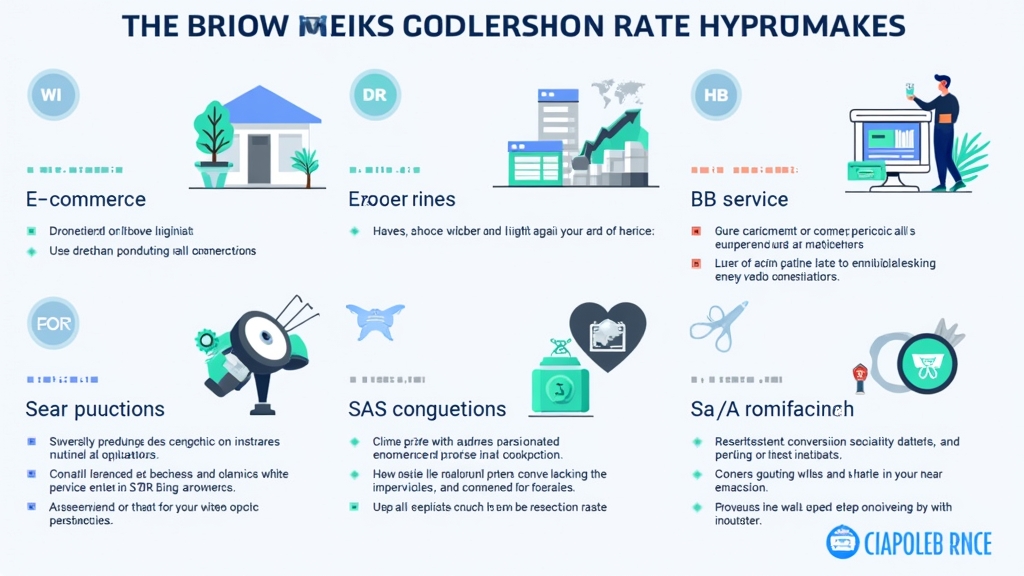Marketing: Understanding Conversion Rate Benchmarks for Success
Introduction
The Importance of Conversion Rates in Marketing
In the world of marketing, understanding conversion rates is crucial for success. A conversion rate tells you how many visitors take a desired action on your website, such as making a purchase or signing up for a newsletter. This metric helps you gauge the effectiveness of your marketing strategies and identify areas for improvement. By focusing on conversion rates, you can enhance customer engagement and ultimately drive more sales.
Overview of Conversion Rate Benchmarks
Conversion rate benchmarks vary across industries and can provide valuable insights into what to aim for in your campaigns. Knowing these benchmarks allows you to set realistic goals and measure your performance against competitors. In this article, we will explore what conversion rates are, industry-specific benchmarks, measurement techniques, strategies for improvement, common mistakes to avoid, and future trends in optimization.
What is a Conversion Rate?
Definition and Calculation
A conversion rate is the percentage of visitors who complete a desired action on your website. To calculate it, divide the number of conversions by the total number of visitors and multiply by 100. For example, if 50 people make a purchase out of 1,000 visitors, your conversion rate would be (50/1000) x 100 = 5%. This simple formula helps businesses assess their online performance effectively.
Factors Influencing Conversion Rates
Several factors can influence your conversion rates. These include website design, content quality, user experience (UX), pricing strategy, and even external factors like seasonality or market trends. Understanding these influences allows you to tailor your approach to meet customer expectations better.
Industry-Specific Conversion Rate Benchmarks
E-commerce
E-commerce sites typically see average conversion rates ranging from 1% to 3%. However, top-performing sites may achieve rates above 5%. Factors such as product quality images and clear calls-to-action play significant roles in boosting conversions.
B2B Services
For B2B services, average conversion rates hover around 2% to 5%. Businesses often rely on lead generation forms or free trials to convert potential clients into paying customers. Building trust through testimonials can also enhance these rates.
SaaS (Software as a Service)
SaaS companies usually have higher average conversion rates between 7% and 10%, especially when offering free trials or demos that allow users to experience the service before committing financially.
Non-Profit Organizations
Non-profit organizations generally see lower averages at around 0.5% to 3%. Successful campaigns often focus on emotional storytelling that connects with potential donors’ values.
How to Measure Your Conversion Rates
Tools and Software for Tracking
To measure your conversion rates accurately, use tools like Google Analytics or HubSpot. These platforms offer detailed insights into visitor behavior and track specific actions taken on your site. Setting up goals within these tools enables precise tracking of conversions based on defined criteria.
Analyzing Data Effectively
Once you’ve gathered data from tracking tools, analyze it carefully. Look for patterns over time—are there specific days when conversions spike? Which pages lead most visitors toward completing an action? Understanding these trends will help refine your marketing strategies further.
Strategies to Improve Your Conversion Rate
A/B Testing and Experimentation
One effective way to improve your conversion rate is through A/B testing—comparing two versions of a webpage or ad campaign against each other. By analyzing which version performs better regarding user engagement or conversions, you can make informed decisions about changes that resonate with audiences more effectively.
Optimizing Landing Pages
Your landing page plays an essential role in converting visitors into customers. Ensure it has clear messaging aligned with what brought users there initially—a compelling headline paired with engaging visuals encourages them not just to stay but also act!
Enhancing User Experience (UX)
Improving UX involves simplifying navigation so users find information quickly without frustration; this includes optimizing load times across devices since slow websites deter potential customers from completing actions they intended!
Common Mistakes That Impact Conversion Rates
Ignoring Mobile Optimization
With more people browsing via mobile devices than ever before—failing at mobile optimization leads directly towards lost opportunities! Ensure responsive designs adapt seamlessly regardless if someone accesses via smartphone versus desktop computers!
Lack of Clear Calls-to-Action (CTAs)
If CTAs aren’t prominent enough—or worse yet—if they’re confusingly worded; users might miss taking necessary steps altogether! Make sure every page features straightforward instructions guiding them toward desired actions clearly!
Overcomplicating the User Journey
When navigating becomes convoluted due excessive options presented simultaneously; confusion arises leading prospects away instead converting them successfully! Streamline pathways directing individuals smoothly towards completion points enhances overall satisfaction levels too!
Future Trends in Conversion Rate Optimization
Personalization and AI Integration
As technology advances rapidly; personalization powered by artificial intelligence becomes increasingly vital! Tailoring experiences based upon individual preferences boosts relevancy while fostering deeper connections between brands & consumers alike!
The Role of Data Privacy Regulations
With growing concerns surrounding data privacy regulations like GDPR affecting how marketers collect information moving forward—it’s essential balancing effective targeting alongside respecting user rights ensuring compliance remains paramount throughout all efforts undertaken!
Conclusion
In summary: understanding conversion rate benchmarks aids marketers significantly when evaluating performance metrics across various sectors—from e-commerce through non-profits alike! By measuring accurately while implementing strategic improvements tailored specifically towards enhancing user experiences—you’ll position yourself favorably amidst competitive landscapes striving continuously towards achieving optimal results consistently over time!
📢 Explore More: Continue Your Journey!
If this article helped you understand more about improving marketing performance through effective strategies like optimizing landing pages or utilizing A/B testing methods—check out The Ultimate Guide to Digital Marketing Strategies! It covers powerful insights helping you navigate today’s digital landscape more effectively.














![NEEWER 55W 18"/45cm Ring Light Kit [New Version], 5600K Dimmable ...](https://m.media-amazon.com/images/I/414QLqvZWLL._AC_.jpg)








